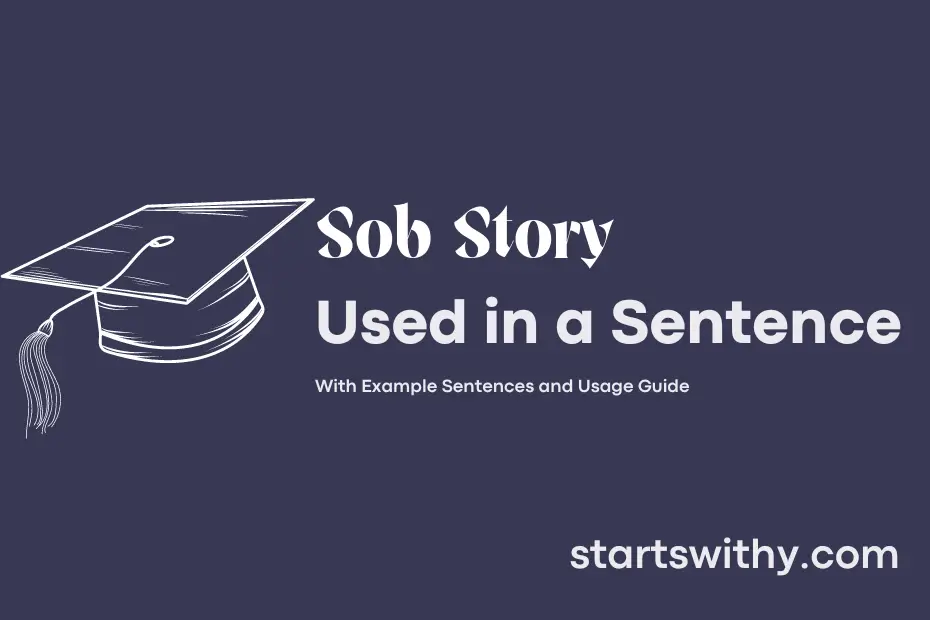Ever heard of a “sob story”? It’s a compelling narrative designed to evoke sympathy or pity from others.
A “sob story” typically involves a personal account of hardship or suffering, often with the intention of gaining favor, assistance, or leniency. These stories are commonly used in various situations to manipulate emotions and elicit a specific response from the audience.
7 Examples Of Sob Story Used In a Sentence For Kids
- My sob story is that I lost my favorite toy.
- She told a sob story about her missing pencil box.
- He shared a sob story about his pet cat running away.
- The little girl had a sob story about losing her lunchbox.
- His sob story was about getting a small boo-boo on his knee.
- She had a big sob story about her broken crayons.
- Their sob story was about the rain ruining their outdoor play.
14 Sentences with Sob Story Examples
- After failing an exam, she told the professor a sob story about how her grandmother passed away the night before and she couldn’t concentrate on her studies.
- He couldn’t afford to buy the recommended textbooks, so he shared a sob story with his friends about his family’s financial struggles.
- She missed a deadline for a project and came up with a sob story about her laptop crashing and losing all her work.
- Unable to pay the hostel fees on time, he showed the hostel warden a sob story about his father’s medical emergency putting a financial strain on the family.
- Wanting an extension on his assignment, he spun a sob story about his pet dog needing emergency surgery.
- To get out of attending a class presentation, she made up a sob story about being too sick to even get out of bed.
- When caught cheating on a test, he concocted a sob story about the immense pressure to perform well due to his family’s high expectations.
- She tried to get extra credit by sharing a sob story about how her part-time job was taking up all her time and affecting her grades.
- He requested a loan from a friend by telling a sob story about his parents cutting off financial support after a heated argument.
- In a bid to get sympathy from the professor, she fabricated a sob story about losing all her notes in a freak accident.
- Failing to submit a group project, he invented a sob story about his teammate falling sick at the last minute and abandoning the project.
- To avoid punishment for plagiarism, she cooked up a sob story about her brother deleting her original work by mistake.
- Seeking forgiveness for missing multiple lectures, he presented a sob story about his only mode of transport breaking down repeatedly.
- Desperate for an internship opportunity, she shared a sob story about being the sole breadwinner in her family and needing the experience to secure a job after graduation.
How To Use Sob Story in Sentences?
To use Sob Story in a sentence, start by incorporating it as a noun to describe a sad or emotionally manipulative tale that someone is telling. For example, “She was known for her ability to weave a convincing sob story whenever she needed help.”
Alternatively, you can use Sob Story as part of a sentence to describe an exaggerated or overly emotional anecdote. For instance, “His frequent sob stories about his personal struggles began to lose their impact on those around him.”
When using Sob Story, keep in mind the context in which it is appropriate. It is typically used in a negative connotation to refer to a story that is designed to evoke sympathy or guilt from others. Consider the tone of your sentence and ensure that it aligns with the intended meaning of Sob Story.
Remember to also consider the audience when incorporating Sob Story into your sentence. Make sure that the context is suitable and that the use of the term is clear to avoid any confusion.
In summary, Sob Story can be effectively used in a sentence to describe a tale that is intended to elicit emotions like sympathy or pity from others. Just remember to use it appropriately and with caution to convey your message effectively.
Conclusion
In conclusion, sentences with sob stories are emotionally charged narratives that often evoke feelings of pity or sympathy in the reader. These sentences typically involve recounting personal struggles, hardships, or tragedies in order to elicit a compassionate response. By using vivid details and emotional appeal, authors can effectively communicate the depth of their experiences and create a strong connection with their audience.
Although sentences with sob stories can be powerful tools for eliciting empathy and understanding, it is essential for writers to use them judiciously. Overuse of sob stories may come across as manipulative or insincere, potentially diminishing their impact. When carefully crafted and integrated into a larger narrative, sentences with sob stories can add depth and emotional resonance to the writing, making a lasting impression on the reader.



